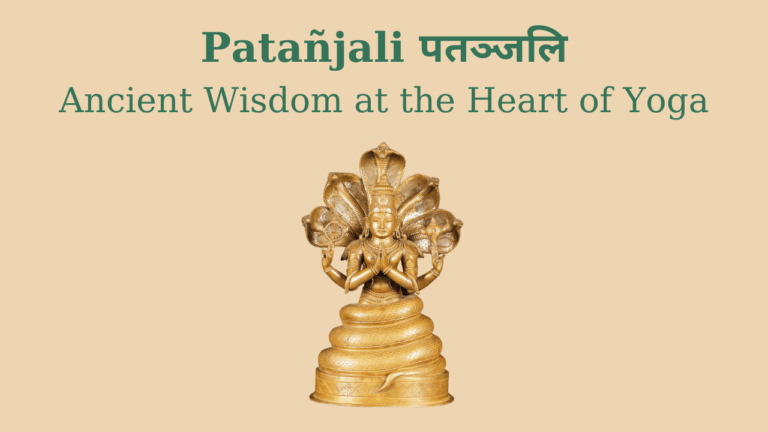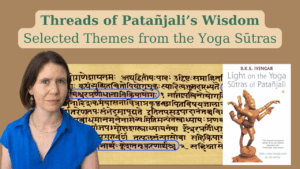
When we speak of yoga today, our minds often turn to physical postures, breathwork, or perhaps even meditation. Yet, beneath these visible layers lies a profound philosophical bedrock, codified by an ancient sage whose insights continue to guide practitioners across millennia. This sage is Patañjali (पतञ्जलि), often revered as the “father of yoga,” and his monumental work, the Yoga Sutras, is not merely a historical text but a living blueprint for human transformation.
For me, encountering Patanjali’s Yoga Sutras was akin to discovering the deepest roots of a majestic tree whose branches I had long admired. My own academic journey into the nuances of yogic philosophy, particularly within the context of Iyengar Yoga, has consistently circled back to these foundational verses. They don’t just offer abstract theories; they provide a psychological and spiritual roadmap for cultivating inner peace, clarity, and liberation. Let me share why Patanjali’s wisdom remains incredibly relevant to our modern lives and why his Sutras are an indispensable part of my study and teaching.
The Genius of Patanjali: Codifying a Timeless Tradition
While Patanjali’s exact identity and historical period remain somewhat debated by scholars – a common fascinating enigma with ancient Indian texts – his genius is undeniable. He didn’t invent yoga; rather, he performed a monumental task of collating, synthesizing, and organizing the existing fragmented knowledge of yoga into a coherent, systematic treatise. Before him, yogic practices were likely transmitted orally or through various schools. Patanjali gave us a concise, aphoristic text that provided a universal framework.
His Yoga Sutras are composed of approximately 195 brief, distilled verses (sutras literally meaning “thread”) that are highly condensed and profound. Each sutra is a seed of wisdom, requiring contemplation and commentary to fully blossom. This brevity is intentional, designed for memorization and deep reflection. Patanjali’s objective was to define yoga, outline its obstacles, describe its practices, and ultimately delineate the path to liberation. His work provided an accessible and logical sequence for self-realization, making the ancient practice understandable and attainable.
Connecting to the Source: The Invocation to Patanjali in Iyengar Yoga
In every Iyengar Yoga class, before we even begin the physical practice, we often come together to chant the Invocation to Patanjali. This isn’t just a ritual; it’s a profound moment of connection – a way to acknowledge the lineage of wisdom that flows through our practice. The specific chant, spoken in Sanskrit, is a heartfelt salutation to Patanjali, acknowledging his profound contributions.
Here are the verses we typically chant, along with their translation, which beautifully illuminate Patanjali’s revered status:
Yogena cittasya padena vacam
To the best of seers, Patanjali,
Who gave us yoga for the serenity of mind,
And grammar for the clarity of speech,
Malam sarirasyaca vaidyakena
And medicine for the purity of the body.
Yopakarottam prvaram muninam
I bow with folded hands to that excellent sage, Patanjali.
Patanjalim pranjaliranato’smi
Whose upper body is human in form,
Abahu purusakaram
Who holds a conch, a discus, and a sword,
Sankha cakrasi dharinam
And whose thousand radiant heads are those of the divine serpent Adi Sesha.
Sahasra sirasam svetam
I salute Patanjali.
Pranamami Patanjalim
Hari Hey Om.
This invocation expresses deep gratitude to Patanjali for his holistic gifts to humanity. We praise him not only for the Yoga Sutras, which purify the mind (citta), but also for his foundational work on Sanskrit grammar, which purifies speech (vacam), and his contributions to Ayurveda, which purifies the body (sarirasya). This comprehensive acknowledgment underscores the integrated nature of Patanjali’s legacy and its direct application to our physical, mental, and verbal expressions.
The visualization of Patanjali’s form in the second part of the chant is particularly rich in symbolism. His human upper body signifies our own human striving. Holding a conch (shankha) represents divine sound and the call to awaken. The discus (chakra) symbolizes cosmic consciousness, eternal law, or the removal of obstacles. The sword (asi) denotes discrimination and wisdom, cutting through ignorance. And his thousand radiant heads are those of Adi Sesha, the divine serpent who supports Lord Vishnu, embodying boundless knowledge, eternal awareness, and perfect balance. For me, this moment of chanting serves as a powerful bridge, grounding our physical efforts in the profound intellectual and spiritual legacy that Patanjali gifted to humanity. It’s a powerful reminder that our postures are not isolated movements but are part of a larger, integrated system aimed at cultivating inner peace and spiritual clarity.
This reverence for Patanjali was central to B.K.S. Iyengar himself. His dedication to making Patanjali’s teachings accessible is evident in his seminal work, Light on the Yoga Sutras of Patanjali. This isn’t just a translation; it’s a deep commentary born from a lifetime of profound practice and direct experience, illuminating the ancient aphorisms with remarkable clarity and practical application. Guruji’s unwavering commitment ensured that the profound wisdom of Patanjali would continue to enlighten practitioners for generations.
The Heart of Patanjali’s Teaching: Chitta Vritti Nirodha
The very first definition of yoga in the Yoga Sutras is perhaps the most famous and foundational:
Yogaś citta-vṛtti-nirodhaḥ (Yoga is the cessation of the fluctuations of the mind.)
This sutra, for me, encapsulates the essence of the yogic journey. Patanjali isn’t primarily concerned with physical gymnastics, but with the state of the mind. He recognized that our suffering largely stems from a restless, agitated, or distracted mind. The “fluctuations” (vritti) refer to the incessant thoughts, emotions, memories, and perceptions that continually disturb our inner peace. Patanjali’s entire system is designed to gradually quiet these mental oscillations, allowing our true nature – a state of pure awareness, joy, and peace – to emerge.
This pursuit of mental clarity and stillness is meticulously outlined in his Eight Limbs of Yoga (Ashtanga Yoga):
These limbs are not sequential steps to be mastered one after the other, but rather interwoven aspects of a holistic practice that develop concurrently. They provide a comprehensive framework for ethical living, physical discipline, mental purification, and spiritual realization.
Patanjali’s Enduring Relevance in My Work
As I delve into the precision of Iyengar Yoga or guide students through trauma-informed practices, Patanjali’s principles are always the underlying current. The meticulous alignment in an asana, for instance, isn’t just about physical form; it’s a profound tool for Dharana (concentration) and Pratyahara (sense withdrawal), pulling the scattered mind into the present moment. The steadiness cultivated on the mat directly impacts our ability to navigate the mental fluctuations Patanjali described.
His Sutras offer invaluable insights into the nature of suffering (duhkha) and the path to freedom from it. In trauma-informed yoga, this understanding is paramount. Patanjali’s emphasis on cultivating clarity, self-awareness, and ethical conduct (Yamas and Niyamas) provides a powerful ethical framework that supports healing and rebuilding a sense of inner security. His psychological model of the mind, with its various states and afflictions, offers a lens through which to understand and address the complexities of trauma. The Sutras provide a compassionate and practical approach to developing inner resources, fostering resilience, and moving towards emotional balance.
Unlocking Patanjali’s Wisdom: An Invitation to Explore
Patanjali’s Yoga Sutras are timeless. They are not merely historical relics but practical guides for anyone seeking to navigate the complexities of life with greater awareness, peace, and purpose. While their aphoristic nature can seem daunting at first, their beauty lies in their profound simplicity once contemplated.
I invite you to explore the depth of Patanjali’s wisdom through the resources I’ve curated here. Dive into my discussions on his philosophical insights, or join my “Yoga Readers” initiative where we collectively unpack these profound texts, exploring their relevance to our lives and practice today. Understanding Patanjali is not just about understanding yoga’s past; it’s about unlocking its transformative power for your present and future.
Continue your journey into the foundations of yoga:
Embark on this intellectual and spiritual exploration, and discover how Patanjali’s ancient wisdom can illuminate your modern path.

A course of selected themes from the Yoga Sutras with Dr. Agi Wittich The Yoga Sūtras of Patañjali are the philosophical heart of yoga.

In a recent Yoga Readers session, Dr. Lois Steinberg opened her teaching archives and personal memories, sharing stories that span four decades of study
Agi Wittich is a yoga practitioner since two decades, and is a certified Iyengar Yoga teacher. Wittich studied Sanskrit and Tamil at the Hebrew University of Jerusalem, Israel, completing a PhD with a focus on Hinduism, Yoga, and Gender. She has published academic papers exploring topics such as Iyengar yoga and women, the effects of Western media on the image of yoga, and an analysis of the Thirumanthiram yoga text.